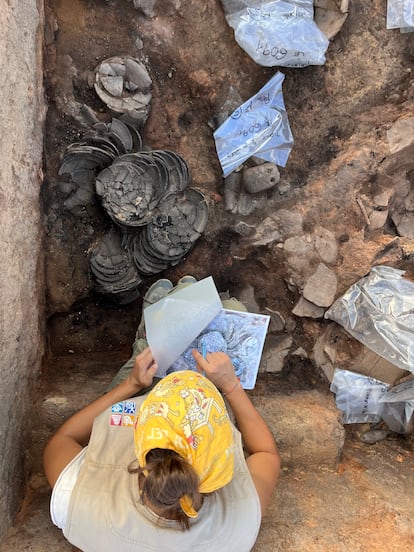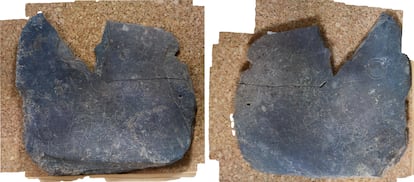The image that heads this news belongs to a small slate tablet that is 2,500 years old. Drawn with some sharp instrument, the scene represents two warriors who are fighting, while at their feet lies a third, completely naked, except for his helmet, and with an erect penis, a common representation in the ancient world of vigor despite the death. On the other side of the tablet (can be seen in the image below), several different faces appear outlined, mixed with other human and geometric figures. Found at the Turuñuelo de Guareña site, in Badajoz, there seems to be no doubt that these are the work sketches of a craftsman or an artist; The tablet even has guide lines, that is, the space is gridded to draw.
It is the first object of these characteristics from the first Iron Age found in the southwest of the peninsula, that is, belonging to the Tartessian culture. “Until now, the craftsman was a completely blurred figure. This type of findings had appeared before, but from the Roman period: slates with floor plans of buildings, with plans… But nothing about this chronology,” explains Esther Rodríguez, researcher at the Institute of Archeology of Mérida (a joint center of the CSIC and the Junta of Extremadura) and co-director of the project with Sebastián Celestino.
If last year the first Tartessian sculptures found to date came to light – five stone busts that began to rewrite the history of art in the ancient Mediterranean -, this small 20×20 centimeter tablet has undoubtedly been one of the great discoveries, presented this Thursday, of the sixth excavation campaign of the Turuñuelo de Guareña. A site that has been offering for almost a decade, as it unearths an imposing two-story building, unique in the western Mediterranean, new keys to understanding Tartessos, the mythical civilization that flourished in the southwest of the peninsula in the first half of the first millennium BC and which suddenly disappeared around the 5th century BC.
The tablet is, in any case, the culmination of the progress made this year, which has allowed us to continue understanding the structure of the building – they have finally found the east door that they had been searching for for years – and get closer than ever to the Tartessian productive organization. through the work of its artisans. “The concept of the building has completely changed, because in front of the east door there is a patio and, in front of it, a wide corridor that separates the main floor from a series of perimeter rooms, all linked to the work of some type of craftsmanship. ”Rodríguez continues.
There are five rooms in total, to which must be added a kitchen and an oven—possibly for baking bread—which are right in front of them, next to the door. Of the perimeter rooms, archaeologists have so far identified the work that was taking place in two of them. One was a potter’s workshop, because there they found, among other things, a seal like the ones these workers used to use in ancient times and about 60 plates, many of which were whole. 42 loom weights have also appeared there, some finished and others in the manufacturing process: they already had the shape, but they were not yet finished, for example, because they were missing the holes to place the threads. “You can perfectly see the operational chain of work of these pieces. We will be able to trace almost the entire chain of what that person did in that room, because he left it all there, on the floor,” explains Rodríguez. And he adds: “There have never been rooms dedicated solely and exclusively to artisan work, much less a table that shows you what the artisan is representing. It’s like having a treasure map.”
That slate tablet was found in another room, hidden behind an amphora, which points to the great importance that its owner attached to his work tool. It is easy to imagine the artist making tests of what he would later capture, from what the size of the drawings suggests, probably on pieces of goldsmithing or on some ivory. Maybe copying what he had around him; On one of the sides of the small blackboard there is drawn an individual with the same physiognomy as the ivories of Etruscan origin that have appeared in other parts of the site. In them, as in those found in Etruria and in Etruscan paintings of the same period, his hands are represented as if they were mittens.
This character is captured in great detail. As are the warriors on the other side of the tablet, perfectly dressed in their clothing and weapons. The one who fights with a spear carries a sword at his waist and you can see the leather cordage or the braiding of the belt. He also sports a braid, similar to that of one of the sculptures found last year, which is a symbol of transition to adulthood very common in the protohistory of the Iberian Peninsula. The researchers interpret that this warrior, because he has more depth of details, would be the winner of the battle that is being represented. The narrative could reflect the fights that occurred between great generals for honor after the death of their leader, their king, their prince; a scene that is documented in times after that of the tablet.

This, like the rest of the objects found in the perimeter rooms, were buried after the fire that followed the ritual process of destruction of this monumental building; It was thoroughly destroyed, burned and abandoned. This process is documented in other smaller constructions around the same time, but in the case of Turuñuelo, they did it after a great banquet and the sacrifice of more than fifty animals, including horses, cows, pigs and a dog, which, appearing in a courtyard around a monumental staircase, form the first hecatomb of comparable size to the religious holocausts described in the Old Testament and the Iliad.
The reason that led its inhabitants to do all this is a mystery that physical tests have not yet been able to reveal, but the certain fact is that, by burning and burying everything, they created a kind of protective urn, thanks to the clay they used. , which has protected the objects from the passage of time in an exceptional way. In the case of the exterior productive rooms, such as the potter’s, it seems that they were not part of the ritual in which all the objects were destroyed before being buried, but were only victims of the fire and the subsequent collapse of the roof. Thus, for example, the ceramics that were higher up, in contact with the ceiling, have appeared more burnt, but, in general, despite the fragmentation of many of them, everything is in fairly good condition. “We are managing to reconstruct the complete pieces. I think that this year we will be able to remove a trousseau of almost 200 pieces, including plates, amphorae, urns…”, predicts Rodríguez.
Subscribe to continue reading
Read without limits
_

